Impact of Drying on Structural Performance of Reinforced Concrete Beam with Slab
Abstract
:1. Introduction
2. Experimental Outline
2.1. Specimen Properties
2.2. Material Properties
2.2.1. Concrete
2.2.2. Reinforcement
2.3. Curing Condition
2.4. Loading Arrangement
3. Experimental Results
3.1. Drying and Shrinkage
3.2. Load–Displacement Relationship
3.3. Crack Patterns
4. Discussion
5. Conclusions
- Although a maximum drying shrinkage strain of −650 μ developed in the specimen cured in the open air, the strain became approximately one-fifth of the average value due to shrinkage cracks that appeared during curing.
- The lateral structural stiffness of the specimen with drying was decreased to 77% of that of the specimen without drying. The reduction of the lateral structural stiffness due to shrinkage was verified through the calculation of the flexural stiffness, considering that the drying shrinkage decreases the moment of inertia of the slab in tension but not in compression (since the shrinkage cracks are thin, cracks get closed even in small compression).
- The reduction ratio of the lateral structural stiffness of the dried specimen to that of the wet specimen does not linearly correlate to the ratio of the flexural stiffness, due to the location of shrinkage-induced cracks that were formed around the edges of the specimen where the specimen was connected to the stub.
- For both specimens and with and without drying, no difference was observed in the drift where the reinforcing bars in the main beams yielded. This is because the drying shrinkage-induced cracks released the accumulated tensile stress in the concrete, and the self-balancing-stress in the reinforcing bars was released or easily released during the cyclic loading process.
Author Contributions
Funding
Institutional Review Board Statement
Informed Consent Statement
Data Availability Statement
Acknowledgments
Conflicts of Interest
Appendix A

Appendix B


References
- Fardis, T.B.; Panagiotakos, M.N. Deformations of Reinforced Concrete Members at Yielding and Ultimate. ACI Struct. J. 2001, 98. [Google Scholar] [CrossRef]
- Mehanny, S.S.F.; Kuramoto, H.; Deierlein, G.G. Stiffness modeling of reinforced concrete beam-columns for frame analysis. ACI Struct. J. 2001, 98, 215–225. [Google Scholar] [CrossRef]
- Khuntia, M.; Ghosh, S.K. Flexural stiffness of reinforced concrete columns and beams: Analytical approach. ACI Struct. J. 2004, 101, 351–363. [Google Scholar] [CrossRef]
- Kumar, R.; Singh, Y. Stiffness of reinforced concrete frame members for seismic analysis. ACI Struct. J. 2010, 107, 607–615. [Google Scholar] [CrossRef]
- Bonet, J.L.; Romero, M.L.; Miguel, P.F. Effective flexural stiffness of slender reinforced concrete columns under axial forces and biaxial bending. Eng. Struct. 2011, 33, 881–893. [Google Scholar] [CrossRef] [Green Version]
- Sugano, S. Study on restoring force characteristics of reinforced concrete members. Concr. J. 1973, 11, 1–9. [Google Scholar]
- Calvi, G.M.; Priestley, N.M.J.; Kowalsky, M.J. Displacement Based Seismic Design of Structures—MJN Priestley high resolution.pdf. In Proceedings of the 5th New Zealand Society for Earthquake Engineering Conference, Wairakei, New Zealand, 11–13 April 2008. [Google Scholar]
- Elwood, K.; Eberhard, M. Effective Stiffness of Reinforced Concrete Columns. ACI Struct. J. 2009, 106, 476–484. [Google Scholar]
- Architectural Institute of Japan (AIJ). Guidelines for Performance Evaluation of Earthquake Resistant Reinforced Concrete Buildings (Draft); AIJ: Tokyo, Japan, 2004. [Google Scholar]
- Architectural Institute of Japan (AIJ). AIJ standard for Structural Calculation of Reinforced Concrete Structures Revised 2018; AIJ: Tokyo, Japan, 2018. [Google Scholar]
- ACI 318 Committee. Building Code Requirements for Structural Concrete (ACI 318-14) and Commentary; American Concrete Institute: Farmington Hills, MI, USA, 2014; ISBN 9780870317446. [Google Scholar]
- British Standard Institution. Eurocode 2: Design of Concrete Structures; British Standard Institution: London, UK, 2011; Volume 1. [Google Scholar]
- Li, Q.; Wang, C.; Ellingwood, B.R. Time-dependent reliability of aging structures in the presence of non-stationary loads and degradation. Struct. Saf. 2015, 52, 132–141. [Google Scholar] [CrossRef]
- Maruyama, I. Multi-scale review for possible mechanisms of natural frequency change of reinforced concrete structures under an ordinary drying condition. J. Adv. Concr. Technol. 2016, 14, 691–705. [Google Scholar] [CrossRef] [Green Version]
- Kurihara, R.; Chijiwa, N.; Maekawa, K. Thermo-hygral analysis on long-Term natural frequency of RC buildings with different dimensions. J. Adv. Concr. Technol. 2017, 15, 381–396. [Google Scholar] [CrossRef] [Green Version]
- Jaafari, C.; Bertrand, D.; Guillot, T.; Prudhomme, E.; Tardif, N.; Georgin, J.F.; Delhomme, F.; Trunfio, R.; Chateur, N.; Bruyere, E.; et al. Effect of early age drying shrinkage on the seismic response of RC structures. Mater. Struct. Constr. 2020, 53, 133. [Google Scholar] [CrossRef]
- Powers, T.C. The mechanics of shrinkage and reversible creep of hardened cement paste. Int. Conf. Struct. Concr. 1965, 319–344. [Google Scholar]
- Feldman, R.F.; Sereda, P.J. A model for hydrated Portland cement paste as deduced from sorption-length change and mechanical properties. Matériaux Constr. 1968, 1, 509–520. [Google Scholar] [CrossRef] [Green Version]
- Wittmann, F.H. Interaction of Hardened Cement Paste and Water. J. Am. Ceram. Soc. 1973, 56, 409–415. [Google Scholar] [CrossRef]
- Ferraris, C.F.; Wittmann, F.H. Shrinkage mechanisms of hardened cement paste. Cem. Concr. Res. 1987, 17, 453–464. [Google Scholar] [CrossRef]
- Helmuth, R.A. The Reversible and Irreversible Drying Shrinkage of Hardened Portland Cement and Tricalcium Silicate Pastes; Portland Cement Association, Research and Development Laboratories: Skokie, IL, USA, 1967. [Google Scholar]
- Maruyama, I.; Igarashi, G.; Nishioka, Y. Bimodal behavior of C-S-H interpreted from short-term length change and water vapor sorption isotherms of hardened cement paste. Cem. Concr. Res. 2015, 73, 158–168. [Google Scholar] [CrossRef]
- Maruyama, I.; Sasano, H. Strain and crack distribution in concrete during drying. Mater. Struct. Constr. 2014, 47, 517–532. [Google Scholar] [CrossRef]
- Carlson, R.W.; Reading, T.J. Model Study of Shrinkage Cracking in Concrete Building Walls. ACI Struct. J. 1988, 85, 395–404. [Google Scholar] [CrossRef]
- Maruyama, I.; Sugie, A. Numerical Study on Drying Shrinkage of Concrete Affected by Aggregate Size. J. Adv. Concr. Technol. 2014, 12, 279–288. [Google Scholar] [CrossRef] [Green Version]
- Idiart, A.; Bisschop, J.; Caballero, A.; Lura, P. A numerical and experimental study of aggregate-induced shrinkage cracking in cementitious composites. Cem. Concr. Res. 2012, 42, 272–281. [Google Scholar] [CrossRef]
- Bisschop, J.; van Mier, J.G. Effect of aggregates on drying shrinkage microcracking in cement-based composites. Mater. Struct. Constr. 2002, 35, 453–461. [Google Scholar] [CrossRef]
- Pickett, G. Effect of Aggregate on Shrinkage of Concrete and a Hypothesis Concerning Shrinkage. ACI J. Proc. 1956, 52, 581–590. [Google Scholar] [CrossRef]
- Carlson, R.W. Drying Shrinkage of Concrete as Affected by Many Factors. Am. Soc. Test. Mater. Proc. 1938, 38, 419–437. [Google Scholar]
- Hansen, T.C.; Nielsen, K.E.C. Influence of Aggregate Properties on Concrete Shrinkage. ACI J. 1965, 62, 783–794. [Google Scholar] [CrossRef]
- Maruyama, I.; Sasano, H.; Lin, M. Impact of aggregate properties on the development of shrinkage-induced cracking in concrete under restraint conditions. Cem. Concr. Res. 2016, 85, 82–101. [Google Scholar] [CrossRef]
- Maruyama, I.; Sasano, H.; Nishioka, Y.; Igarashi, G. Strength and Young’s modulus change in concrete due to long-term drying and heating up to 90 °C. Cem. Concr. Res. 2014, 66, 48–63. [Google Scholar] [CrossRef]
- Tanimura, M.; Sato, R.; Hiramatsu, Y. Serviceability performance evaluation of RC flexural members improved by using low-shrinkage high-strength concrete. J. Adv. Concr. Technol. 2007, 5, 149–160. [Google Scholar] [CrossRef] [Green Version]
- Sasano, H.; Maruyama, I.; Nakamura, A.; Yamamoto, Y.; Teshigawara, M. Impact of drying on structural performance of reinforced concrete shear walls. J. Adv. Concr. Technol. 2018, 16, 210–232. [Google Scholar] [CrossRef] [Green Version]
- Sato, R.; Kawakane, H. A new concept for the early age shrinkage effect on diagonal cracking strength of reinforced HSC beams. J. Adv. Concr. Technol. 2008, 6, 45–67. [Google Scholar] [CrossRef] [Green Version]
- Nakarai, K.; Morito, S.; Ehara, M.; Matsushita, S. Shear strength of reinforced concrete beams: Concrete volumetric change effects. J. Adv. Concr. Technol. 2016, 14, 229–244. [Google Scholar] [CrossRef] [Green Version]
- Satya, P.; Asai, T.; Teshigawara, M.; Maruyama, I. Experimental Study to Evaluate Yielding Point of a Reinforced Concrete Beam with Slab. Proc. Japan Concr. Inst. 2020, 42, 217–222. [Google Scholar]
- Japanese Concrete Institute. Method of Test for Fracture Energy of Concrete by Use of Notched Beam. 2003. Available online: http://www.jci-net.or.jp/j/jci/study/jci_standard/JCI-S-001-2003-e.pdf (accessed on 9 February 2021).
- Bentz, E.C. Sectional Analysis of Reinforced Concrete Members; University of Toronto: Toronto, ON, Canada, 2000. [Google Scholar]
- Popovics, S. A Numerical Approach to Complete the Stress Strain Curve of Concrete. Cem. Concr. Res. 1973, 21, 583–599. [Google Scholar] [CrossRef]
- Shunsuke Sugano, I.K. Empirical evaluation of inelastic behavior of structural elements in reinforced concrete frames subjected to lateral forces. In Proceedings of the Fifth World Conference on Earthquake Engineering, Rome, Italy, 25– 29 June 1974; pp. 841–844. [Google Scholar]
- Achiha, Y.; Teshigawara, M.; Asai, T.; Maruyama, I.; Kusunoki, K.; Suwada, H.; Sakashita, M.; Maita, H. A Study on Damping Property of RC Structures Part 11 Drying Effect on Yield Displacement of RC Column. Proc. AIJ Annu. Meet. 2020, 461–462. [Google Scholar]

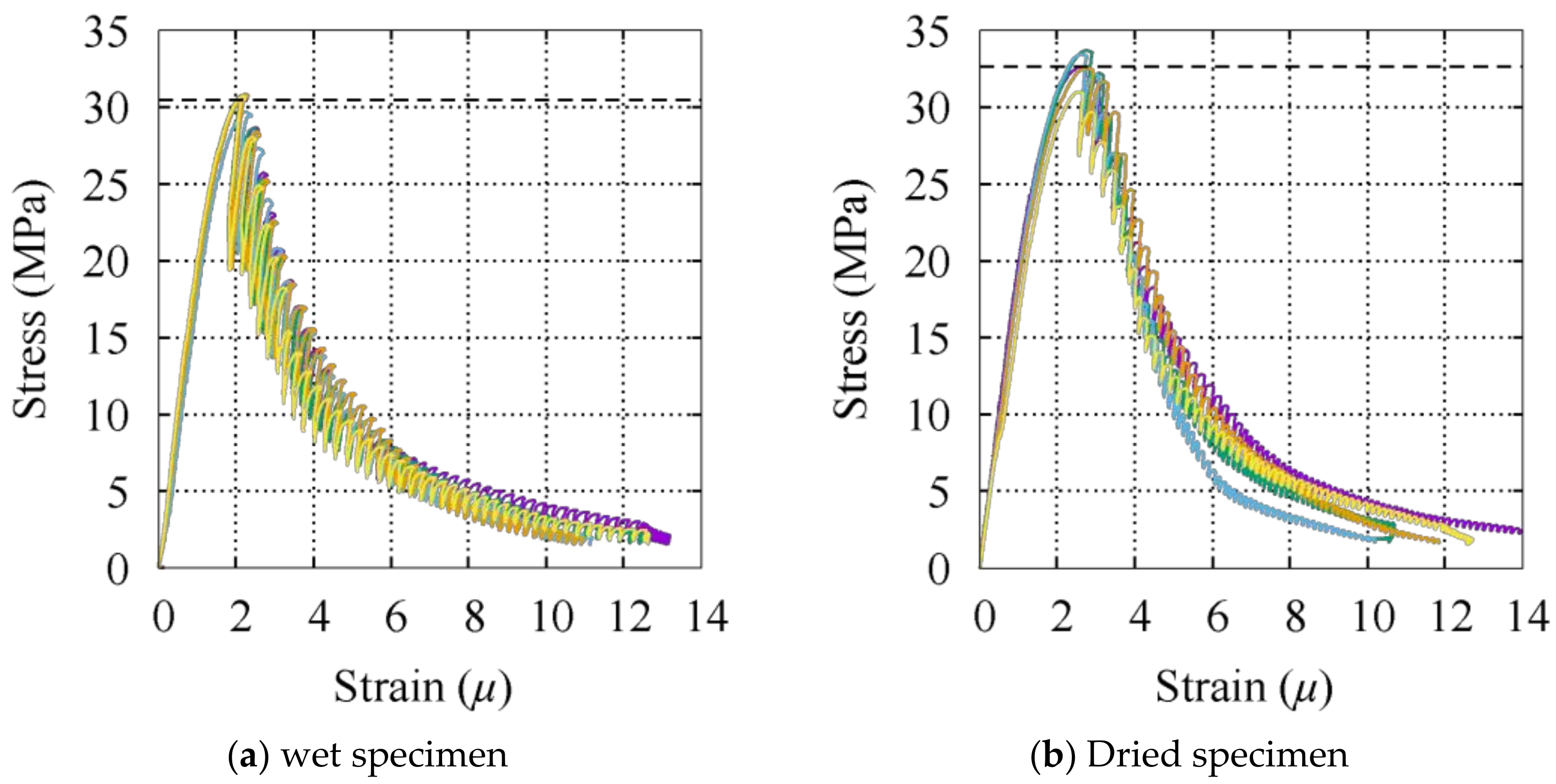
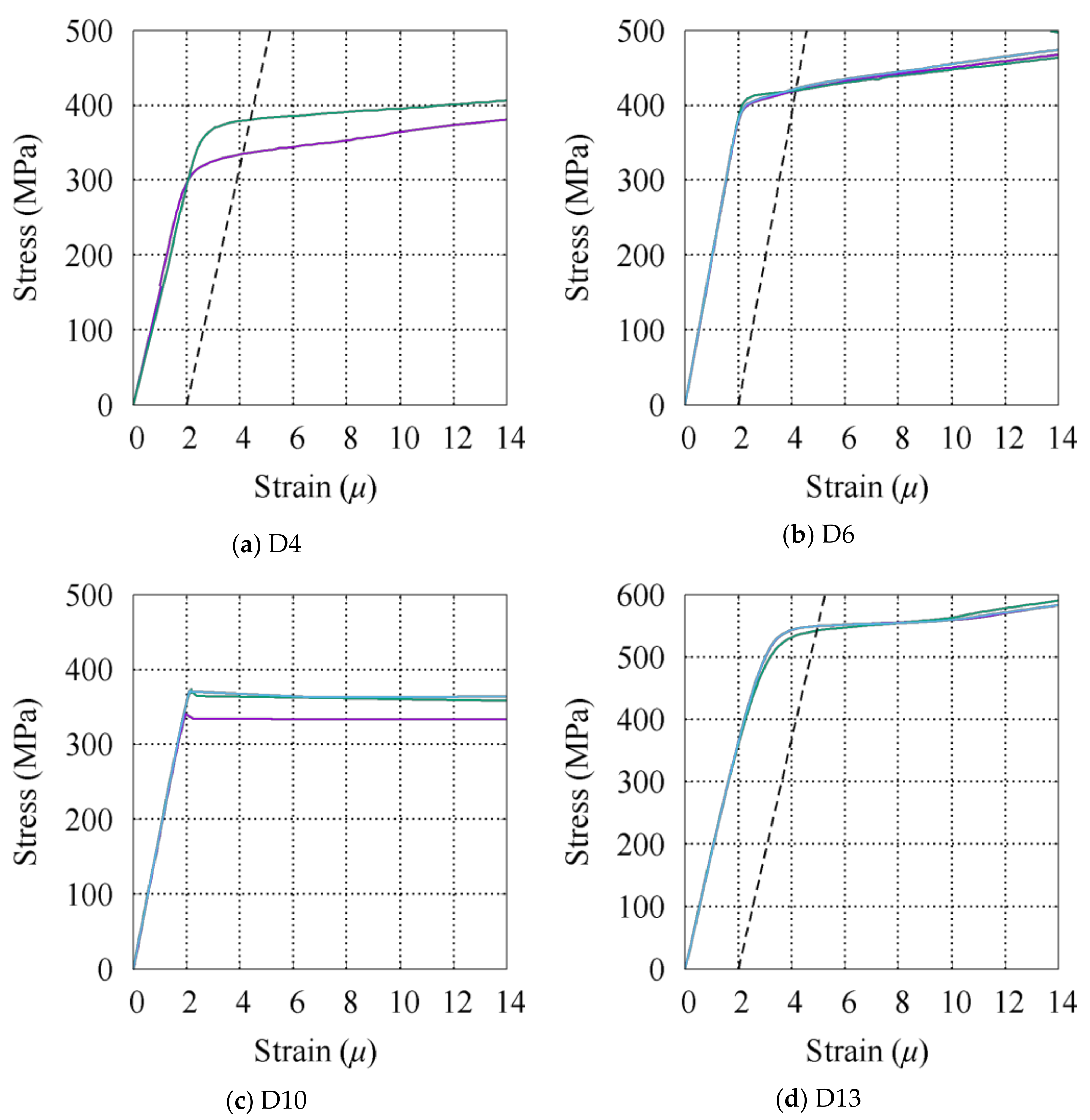
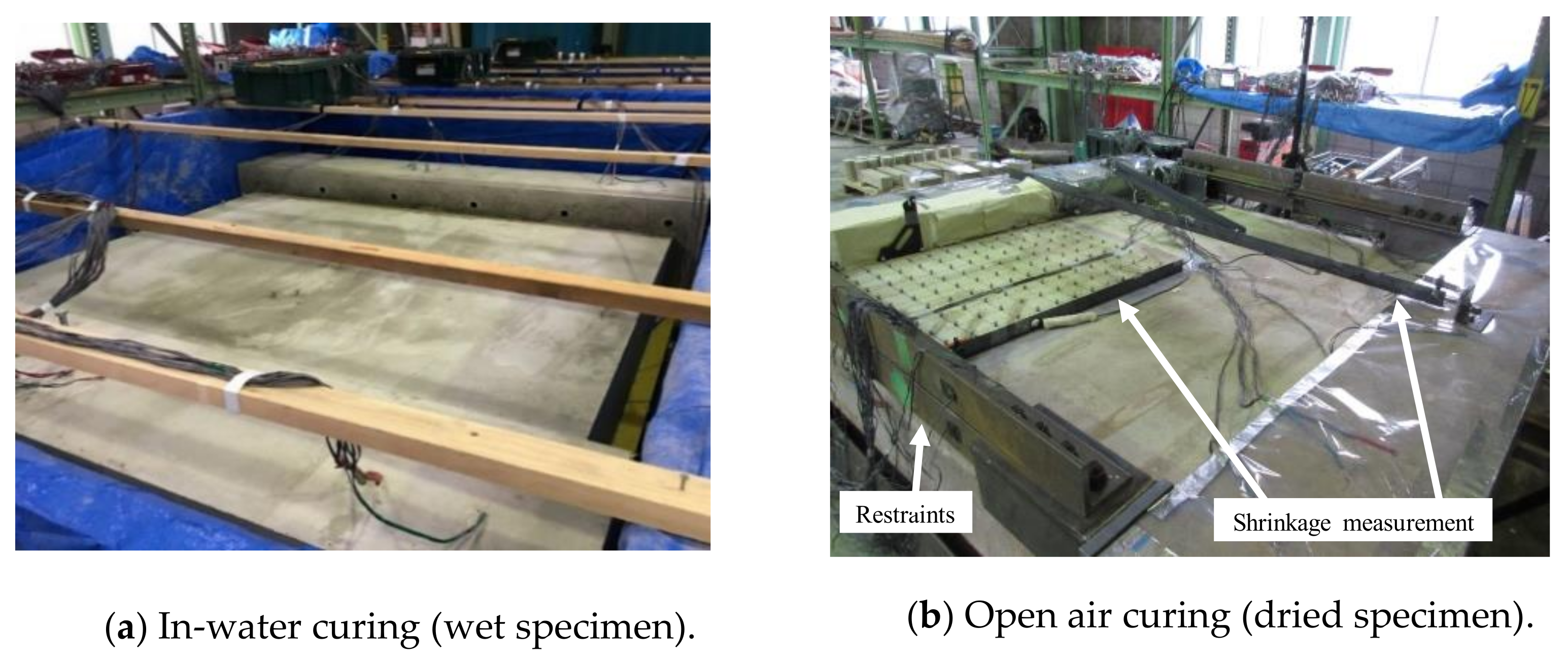
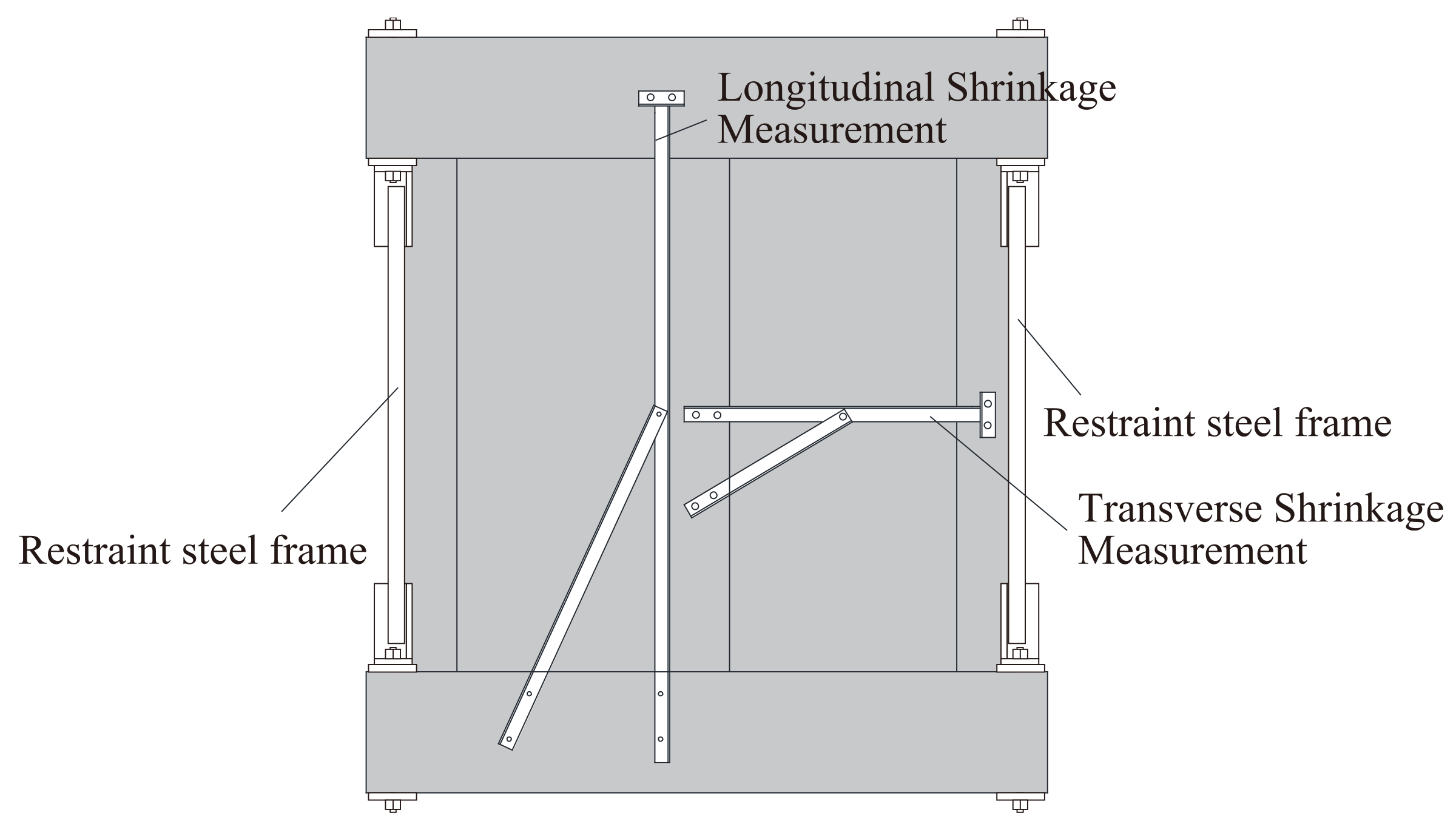

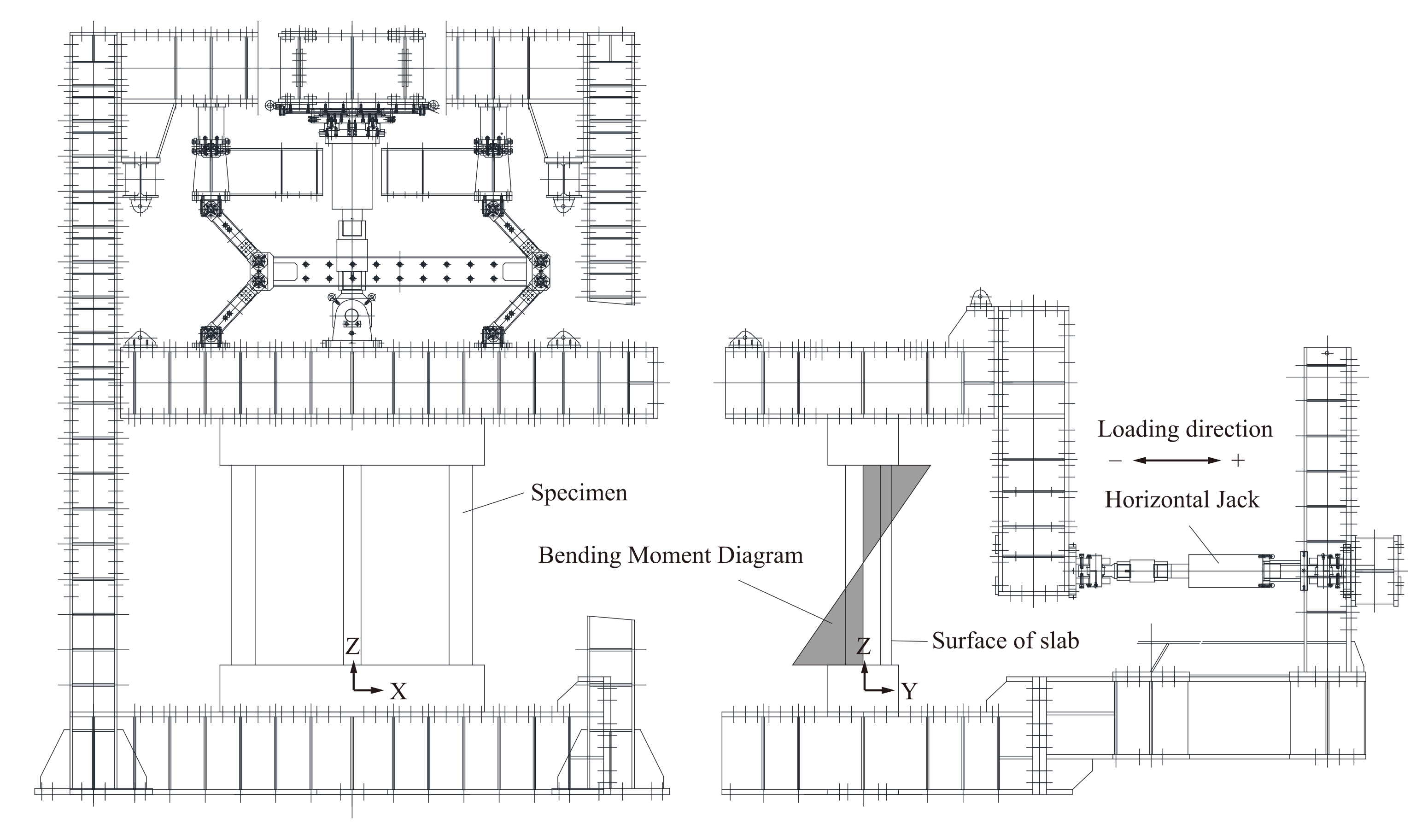
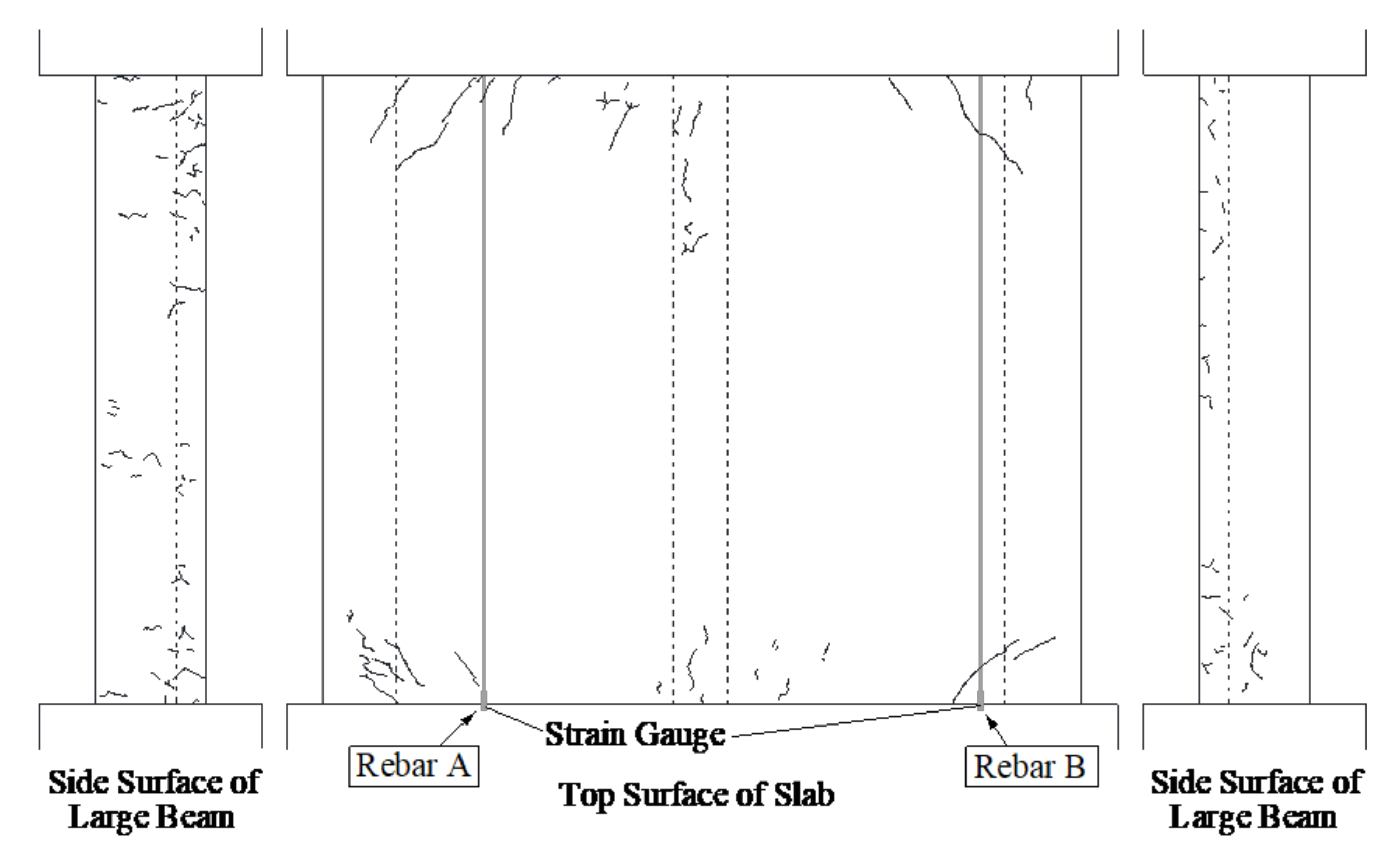
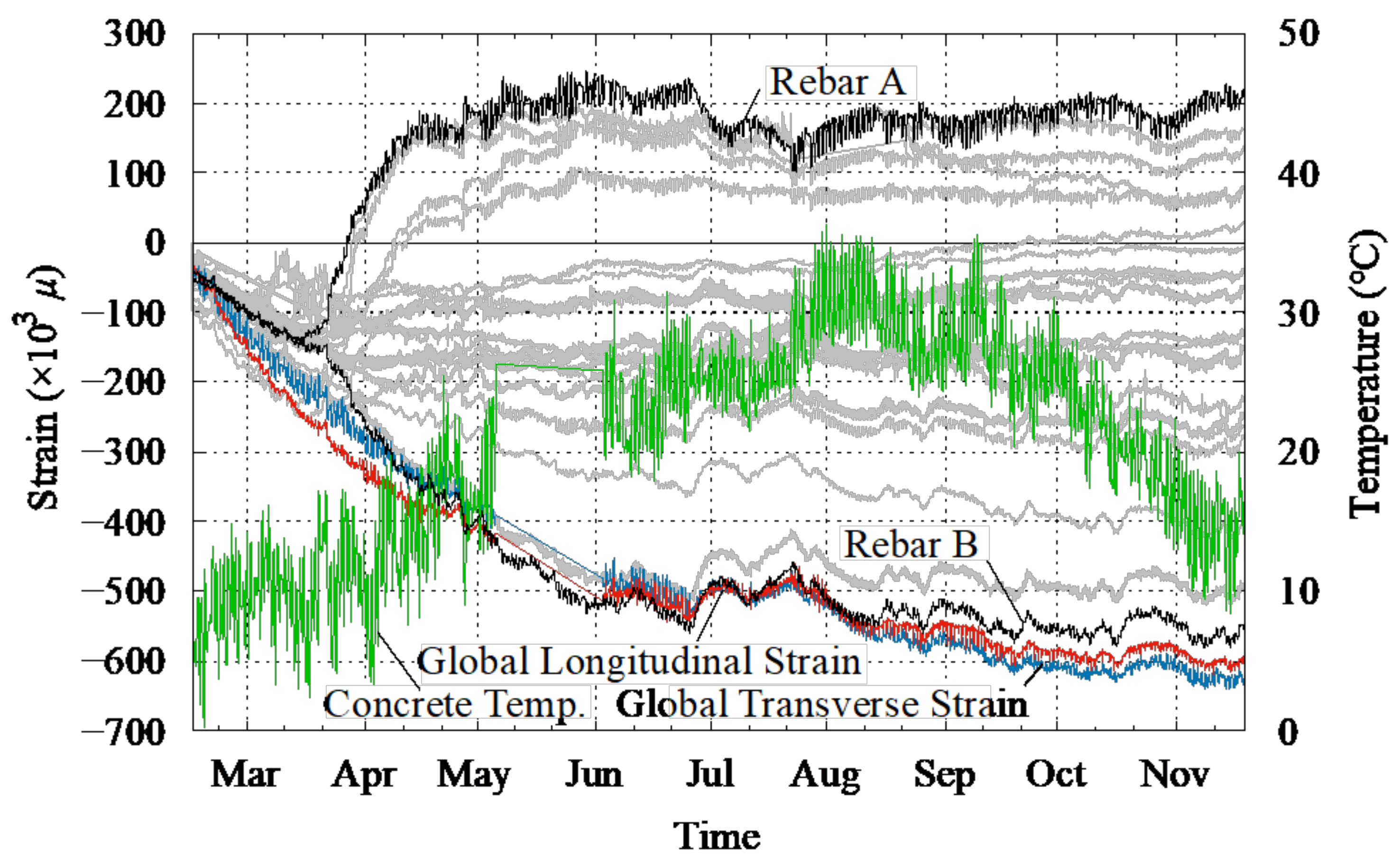
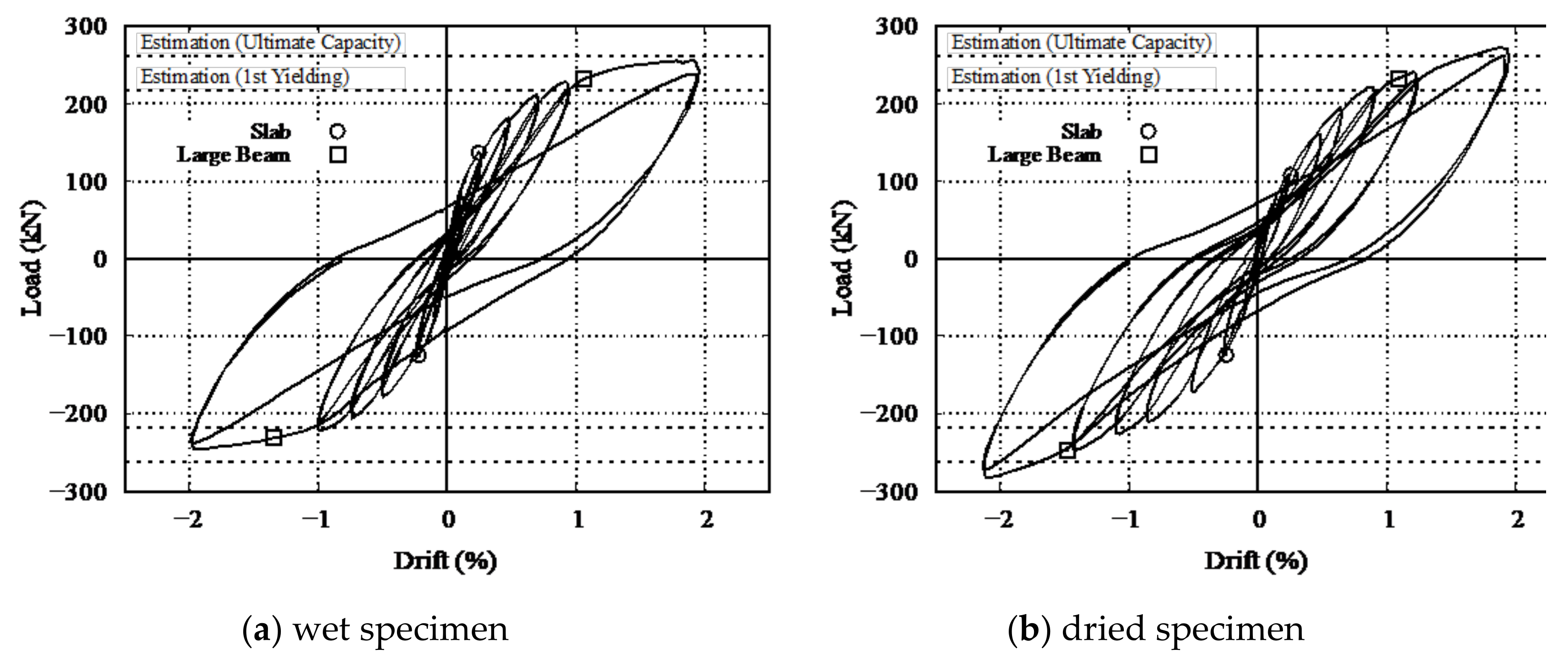


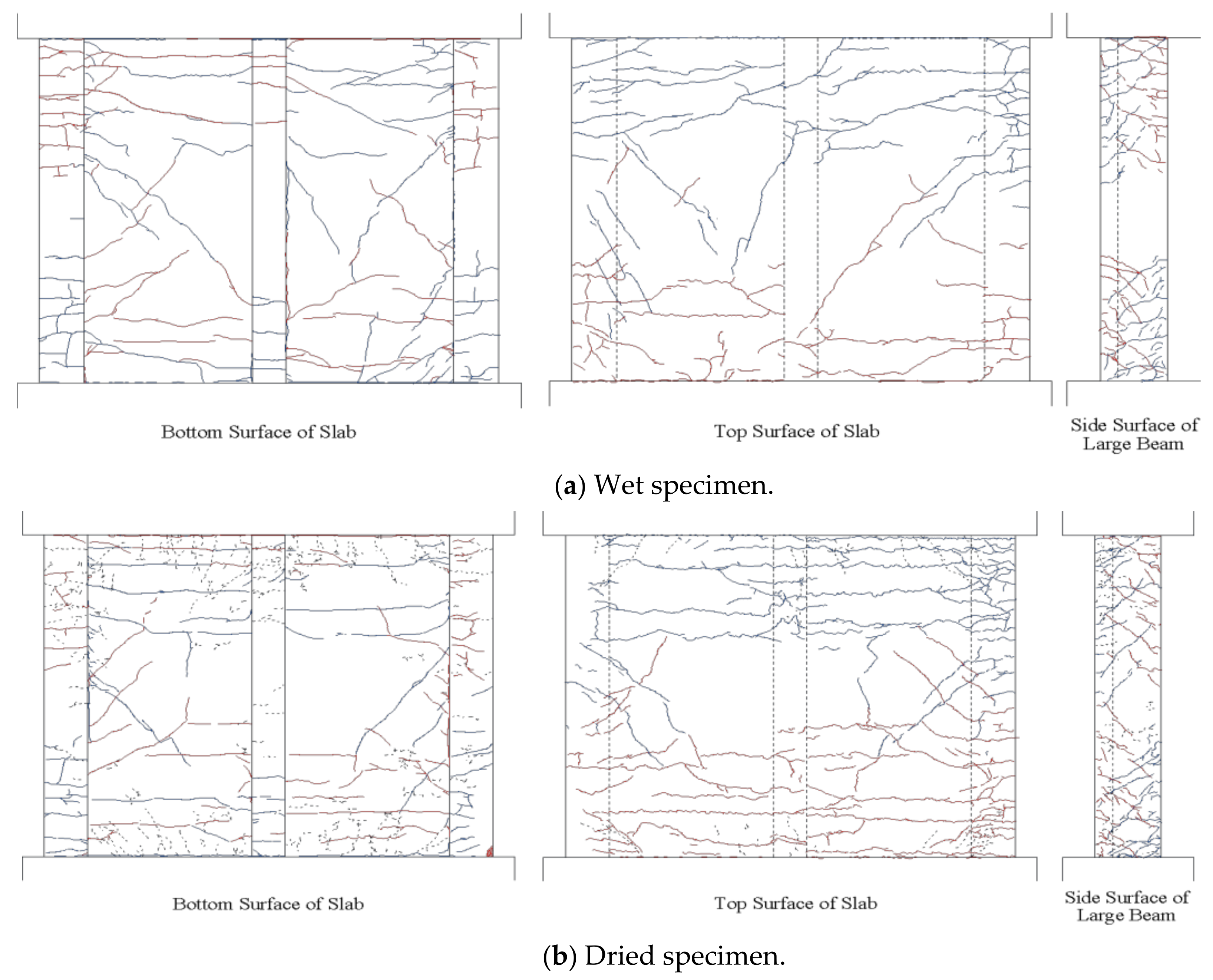
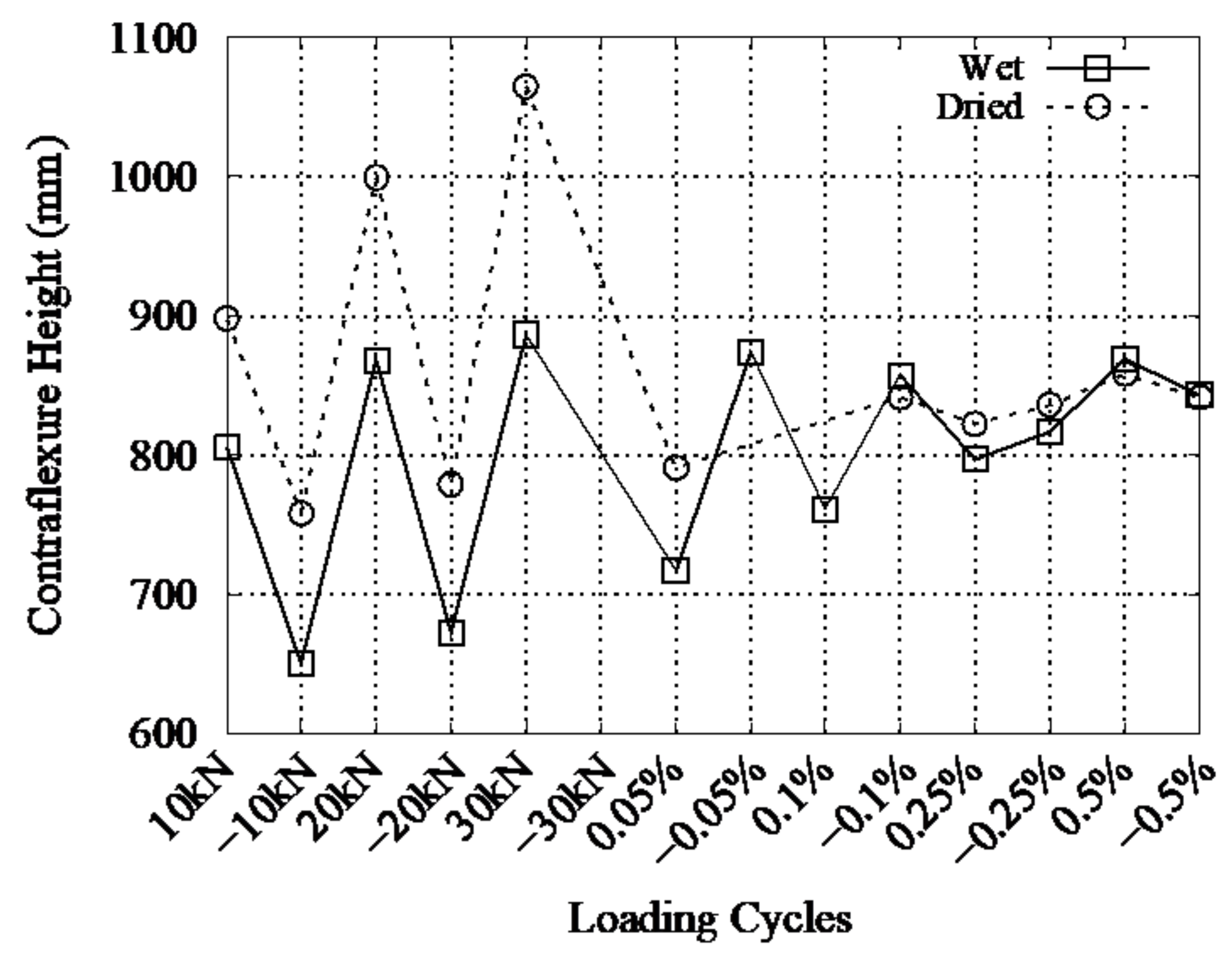
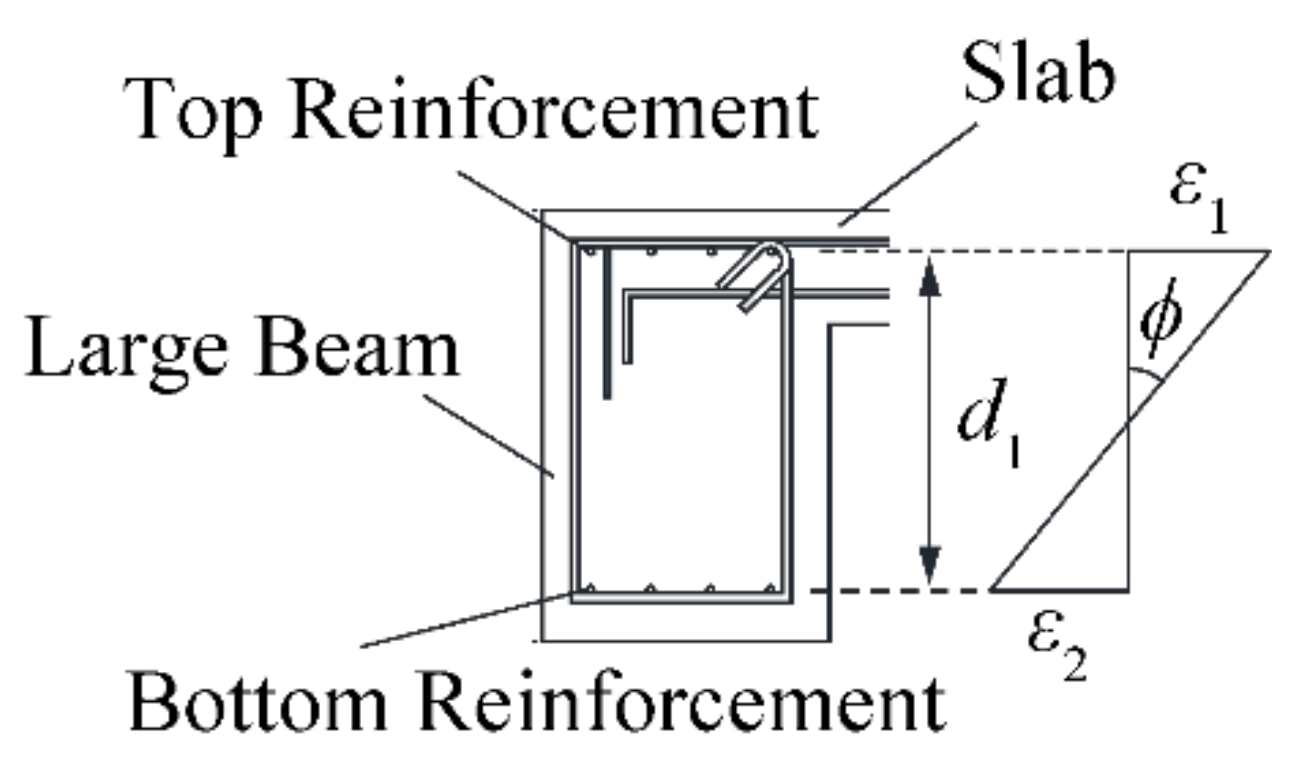


| Mixture Proportion | Fresh Properties | ||||||||
|---|---|---|---|---|---|---|---|---|---|
| W/C (%) | s/a (%) | Mass (kg/m3) | Slump (mm) | Air (%) | Temp. (°C) | ||||
| W | C | G | S | AE * | |||||
| 60.8 | 51.2 | 182 | 300 | 854 | 885 | 3 | 180 | 4.5 | 8 |
| Specimen | Curing Period | fc (MPa) | ft (MPa) | Ec (GPa) | Gft (Nm) |
|---|---|---|---|---|---|
| Wet Specimen | Concrete specimens for property tests: tested after 110 days of curing in water | 30.5 | 2.85 | 25.7 | 107.9 |
| Beam–slab specimen: loaded after 90 days of curing in water plus 10 days of preparation | |||||
| Dried Specimen | Concrete specimens for property tests: tested after 107 days of curing in water plus 318 days of drying | 32.6 | 2.47 | 23.7 | 136.1 |
| Beam–slab specimen: loaded after 107 days of curing in water plus 319 days of drying and preparation |
| Rebar Type | Location | Type of Steel | Es (GPa) | fy (MPa) | fu (MPa) |
|---|---|---|---|---|---|
| D4 | Slab | SD345 | 170 | 357 | 489 |
| D6 | Stirrups | SD345 | 161 | 420 | 682 |
| D10 | Sub-beam | SD345 | 173 | 355 | 514 |
| D13 | Large beam | SD490 | 178 | 545 | 734 |
| Loading Control | Load Controlled | Drift Controlled | |||||||||||
|---|---|---|---|---|---|---|---|---|---|---|---|---|---|
| Load (kN)/Drift (%) | 10 | 20 | 30 | 0.05 | 0.1 | 0.25 | 0.5 | 0.75 | 1 | 1.3 | 2 | 4 | |
| Number of Cycles | Wet specimen | 1 | 1 | 1 | 1 | 1 | 2 | 2 | 0 | 2 | 0 | 2 | 2 |
| Dried specimen | 1 | 1 | 1 | 0 | 1 | 1 | 1 | 1 | 2 | 2 | 2 | 2 | |
| Load | Experimental Lateral Stiffness | Estimated Lateral Stiffness, K0 | |||
|---|---|---|---|---|---|
| Wet | Dry | Dry/Wet | AIJ | ACI | |
| 10 kN | 78 | 59 | 0.76 | 104 | 82 |
| 30 kN | 70 | 54 | 0.77 | ||
Publisher’s Note: MDPI stays neutral with regard to jurisdictional claims in published maps and institutional affiliations. |
© 2021 by the authors. Licensee MDPI, Basel, Switzerland. This article is an open access article distributed under the terms and conditions of the Creative Commons Attribution (CC BY) license (https://creativecommons.org/licenses/by/4.0/).
Share and Cite
Satya, P.; Asai, T.; Teshigawara, M.; Hibino, Y.; Maruyama, I. Impact of Drying on Structural Performance of Reinforced Concrete Beam with Slab. Materials 2021, 14, 1887. https://doi.org/10.3390/ma14081887
Satya P, Asai T, Teshigawara M, Hibino Y, Maruyama I. Impact of Drying on Structural Performance of Reinforced Concrete Beam with Slab. Materials. 2021; 14(8):1887. https://doi.org/10.3390/ma14081887
Chicago/Turabian StyleSatya, Pranjal, Tatsuya Asai, Masaomi Teshigawara, Yo Hibino, and Ippei Maruyama. 2021. "Impact of Drying on Structural Performance of Reinforced Concrete Beam with Slab" Materials 14, no. 8: 1887. https://doi.org/10.3390/ma14081887







